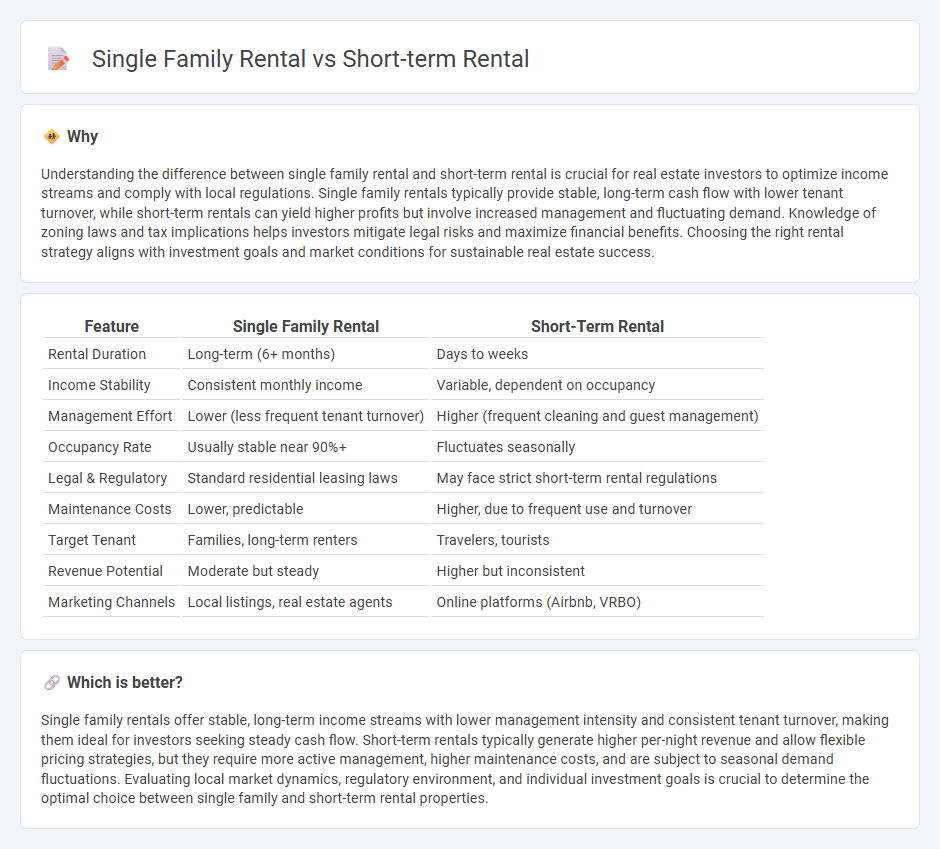
Single family rentals offer stable, long-term income through extended lease agreements, attracting tenants seeking consistent housing. Short-term rentals generate higher revenue by catering to travelers and vacationers with flexible, nightly bookings, but require more active management and variable occupancy rates. Explore the benefits and challenges of each rental strategy to determine the ideal investment approach for your real estate portfolio.
Why it is important
Understanding the difference between single family rental and short-term rental is crucial for real estate investors to optimize income streams and comply with local regulations. Single family rentals typically provide stable, long-term cash flow with lower tenant turnover, while short-term rentals can yield higher profits but involve increased management and fluctuating demand. Knowledge of zoning laws and tax implications helps investors mitigate legal risks and maximize financial benefits. Choosing the right rental strategy aligns with investment goals and market conditions for sustainable real estate success.
Comparison Table
| Feature | Single Family Rental | Short-Term Rental |
|---|---|---|
| Rental Duration | Long-term (6+ months) | Days to weeks |
| Income Stability | Consistent monthly income | Variable, dependent on occupancy |
| Management Effort | Lower (less frequent tenant turnover) | Higher (frequent cleaning and guest management) |
| Occupancy Rate | Usually stable near 90%+ | Fluctuates seasonally |
| Legal & Regulatory | Standard residential leasing laws | May face strict short-term rental regulations |
| Maintenance Costs | Lower, predictable | Higher, due to frequent use and turnover |
| Target Tenant | Families, long-term renters | Travelers, tourists |
| Revenue Potential | Moderate but steady | Higher but inconsistent |
| Marketing Channels | Local listings, real estate agents | Online platforms (Airbnb, VRBO) |
Which is better?
Single family rentals offer stable, long-term income streams with lower management intensity and consistent tenant turnover, making them ideal for investors seeking steady cash flow. Short-term rentals typically generate higher per-night revenue and allow flexible pricing strategies, but they require more active management, higher maintenance costs, and are subject to seasonal demand fluctuations. Evaluating local market dynamics, regulatory environment, and individual investment goals is crucial to determine the optimal choice between single family and short-term rental properties.
Connection
Single-family rentals and short-term rentals both capitalize on residential real estate to generate income, appealing to investors seeking diversified cash flow strategies. Single-family rentals offer stable, long-term tenancy, while short-term rentals leverage platforms like Airbnb to maximize nightly rates through flexible occupancy. This connection enables real estate investors to balance steady income with high-yield opportunities in the evolving housing market.
Key Terms
Occupancy Rate
Short-term rentals typically achieve occupancy rates ranging from 60% to 80%, driven by location appeal and seasonal demand fluctuations, while single-family rentals maintain steadier occupancy around 90% due to longer lease commitments. Short-term rental vacancy rates can spike during off-peak seasons or economic downturns, affecting overall revenue stability. Explore deeper insights into occupancy dynamics to optimize your rental investment strategy.
Lease Term
Short-term rentals typically offer lease terms ranging from a few days to several months, providing flexibility for travelers and temporary residents. Single-family rentals usually require longer lease commitments, often six to twelve months or more, catering to tenants seeking stability and a permanent home. Explore the key differences in lease terms to determine which rental option best fits your housing needs.
Cash Flow
Short-term rentals typically achieve higher daily rates but incur increased management costs and vacancy risks, impacting overall cash flow. Single-family rentals offer more stable, predictable income with lower turnover expenses, providing consistent monthly cash flow. Explore detailed comparisons to determine which rental strategy maximizes your investment returns.
Source and External Links
What is Considered a Short-Term Rental? - GovOS - This webpage explains the definition and types of short-term rentals, including entire homes, accessory dwellings, and rooms.
Short-Term & Temporary Housing - Extended Stay America - Offers temporary housing solutions providing the comfort and freedom of an apartment without long-term commitments.
Temporary Housing in Toledo, OH - Short Term Rentals - Provides access to numerous temporary housing options in Toledo, suitable for various needs such as relocation or emergency situations.
 dowidth.com
dowidth.com